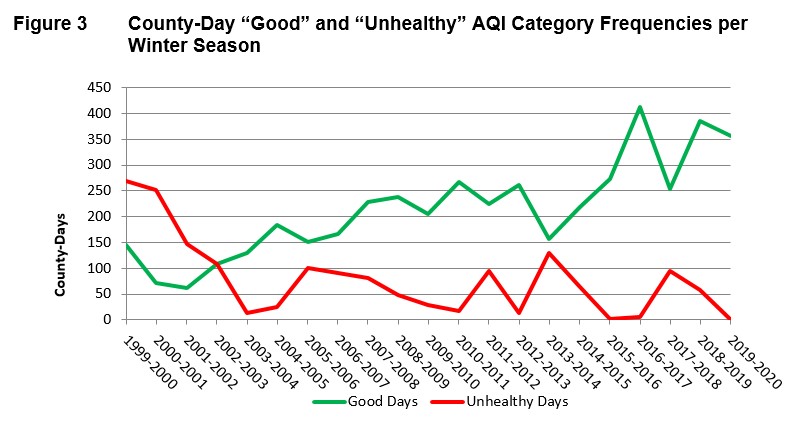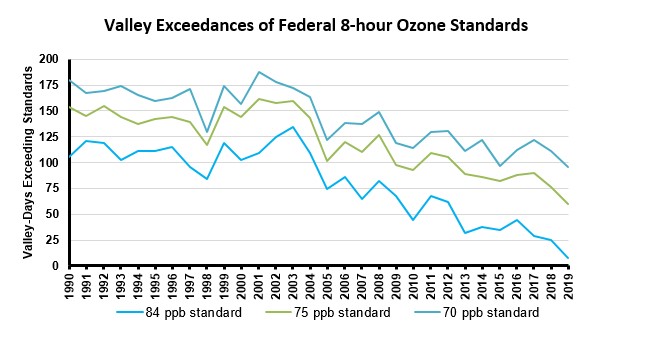2019-2020 PM2.5 Season was Cleanest on Record
During the 2019-2020 winter season (November through February), the Valley continued to demonstrate significantly improved air quality. Despite experiencing one of the driest winter seasons on record, the Valley continues to progress towards attaining the federal PM2.5 standards. These continued improvements in air quality would not have been possible without the emissions reductions achieved under the District’s control strategies, including the comprehensive residential wood burning emissions reduction strategy, as well as the commitment from the Valley’s residents to reduce emissions in their daily activities. In fact, the Valley still meets the 65 µg/m3 federal 24-hour PM2.5 standard and is continuing to make progress towards the 35 µg/m3 standard.
- Recorded the greatest number of “Good” and “Moderate” AQI days across all of the counties in the District
- Recorded the lowest average PM2.5 concentration across all counties during the months of the wood burning season
- Recorded the lowest number of days the counties throughout the Valley exceeded the 35 µg/m3 federal 24-hour PM2.5 standard
- For the first time, recorded zero days any county throughout the Valley measured Unhealthy AQI for PM2.5 during the months of the wood burning season
- For the third winter season, recorded zero exceedances of the 65 µg/m3 federal 24-hour PM2.5 standard

Record Setting Air Quality in 2019
The San Joaquin Valley experienced record improvements across several key 8-hour ozone metrics in 2019, including the fewest number of days exceeding the 84 ppb, 75 ppb, and 70 ppb federal standards, and the Valley’s lowest federal “design value” (official metric used to determine whether an area is in attainment of federal standards). The Valley’s progress in lowering ozone pollution concentrations has been achieved despite being influenced from many challenging factors, including long strings of high summertime temperatures, extreme wildfires in recent years, and extended periods of atmospheric stability where pollution easily builds in the bowl of the Valley.
These improvements would not be possible without the success of the District’s control strategy through its various attainment planning efforts, robust incentive programs, strong public education efforts, commitment and significant investment from Valley businesses and residents, the agricultural community, and other stakeholders in doing their part to reduce emissions.
- 2019 was a record-setting year for ozone progress with the fewest number of exceedances of the 84 ppb and 75 ppb standards since 1990, with only 8 exceedances of the 84 ppb standard (91% reduction since 1990) and 65 exceedances of the 75 ppb standard (58% reduction since 1990)
- In 2019, the Valley continued to demonstrate ongoing ozone progress by achieving a new record low design value of 88 ppb, which is now only 4 ppb away from attaining the 84 ppb standard. The 2019 design value represents a 31 ppb reduction since a peak in this value in 1995.
- Peak ozone values in 2019 alone were below the federal standard, demonstrating the Valley’s progress in attaining the 84 ppb standard
- Valley’s population exposure to high ozone concentrations have decreased by 83% to 99% for the federal ozone standards since the 1990s


Record Setting Air Quality in 2018 Read More
Record Setting Air Quality in 2017 Read More
Record Setting Air Quality in 2016 Read More
Record Setting Air Quality in 2015 Read More
|